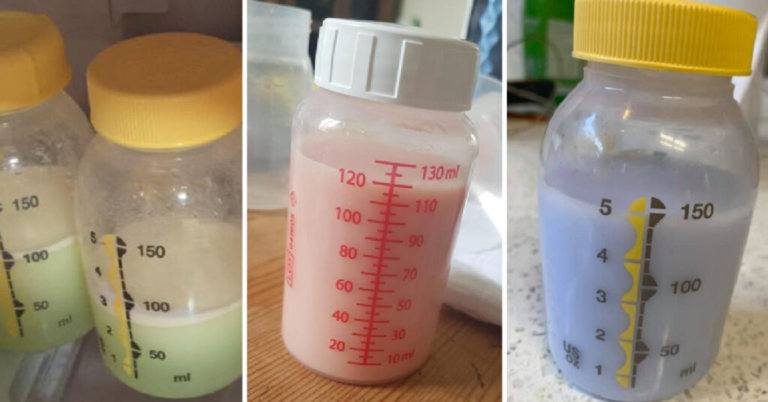Is It OK to Just Pump and Not Breastfeed?

Nursing directly from the breast and formula-feeding from a bottle are not the only ways to feed your baby. More parents are exclusively pumping breast milk to bottle-feed. Learn why.
Shafonne Myers, a mom of three from Fishers, Indiana, is no stranger to the midnight nursing ritual. For over a decade, she has cradled and rocked her children back to sleep in a dimly lit nursery. Now, with her youngest, instead of the familiar cooing and suckling of a feeding baby, Myers listens to the steady whirr of a breast pump while her baby drinks from a bottle.
Myers is among the growing number of parents who exclusively pump their breast milk rather than nurse directly. “I nursed for the first three weeks, and it was hell,” she recalls. Due to her inverted nipples, her baby had trouble latching and wasn’t feeding well. Her doctor suggested supplementing with formula.
“I didn’t want to supplement because I really wanted to strictly give her breast milk for as long as I could,” she says. When her baby didn’t gain weight, Myers turned to pumping to ensure her baby was getting enough milk. “I was really discouraged but found out that exclusively pumping was the best option for me,” she says.
Read on to understand why it’s perfectly fine to exclusively pump and not directly breastfeed, along with the challenges and benefits of this feeding method.
Related: What Is Colostrum? Everything You Need To Know
Why Parents Choose to Pump and Not Breastfeed
The World Health Organization (WHO) recommends exclusive breastfeeding for the first six months and continuing for up to two years or longer. However, breastfeeding—especially nursing directly—doesn’t always come easily. Many find it inconvenient, painful, or impossible for various reasons. According to the Centers for Disease Control and Prevention (CDC), only 24.9% of infants in the U.S. were exclusively breastfed through six months in 2022.
Medical Reasons
Some circumstances prevent direct breastfeeding, such as radiation treatment, certain breast surgeries, or specific medications. The New York Department of Health also lists situations where breastfeeding isn’t advisable, but expressed breast milk can be offered, including:
- Active tuberculosis (TB)
- Active herpes lesions
- Varicella (chickenpox)
It’s worth noting that breastfeeding might still be possible in some cases, such as covering chickenpox lesions or treating TB with medication. Consult a healthcare provider to determine if breastfeeding can continue.
Veronica Haywood, RN, co-founder and executive director of Latched, a support group for breastfeeding parents in San Antonio, Texas, explains that exclusive pumping may be the only option for some families if either parent or baby has medical complications that prevent breastfeeding directly from the breast.
Lifestyle Reasons
For Myers, nursing wasn’t working with her busy schedule. “The thought of nursing while having to take my other kids places just didn’t make sense,” she says. “Pumping works with our lifestyle.” On a recent 10-hour drive to Virginia, she found pumping convenient: “Luckily, our truck has an outlet, so I just plugged in and pumped with my electric pump,” she says.
The Challenges of Pumping and Not Breastfeeding
While exclusively pumping can be a great alternative, it comes with its own set of obstacles:
Time Commitment
Kara Manglani, CNM, a nurse-midwife from New York City, says the major drawback is the time commitment. To maintain a supply, you’d need to pump every time you feed with a bottle, typically every three hours, including the middle of the night. This mimics the regular feeding schedule of a baby, which stimulates milk production.
Cost
Exclusively pumping can be pricey. While direct nursing costs nothing, pumping requires an electric pump, storage bottles or bags, and possibly additional parts for the best results. Some insurance plans cover certain breast pumps, but there are higher-end options like wearable pumps that may be more comfortable or convenient. Without assistance, a double electric pump can cost $150 to $500. Additional accessories and parts can also add to the cost.
Logistics
Finding a comfortable space to pump, often with an outlet, is another challenge. Not all public nursing rooms have accessible outlets, so it’s worth calling ahead if you’re traveling or spending time in a new location. You’ll also need bottles to feed your baby and storage solutions for any extra supply.
The Benefits of Pumping and Not Breastfeeding
Despite the challenges, many parents find the benefits of pumping outweigh the downsides:
Freedom and Flexibility
Pumping allows parents to be away from their babies during mealtimes and still provide milk for later. This flexibility can be invaluable for those with busy schedules. Myers found that she could bond with her baby just as much while bottle-feeding as she did with breastfeeding, without the struggle of getting situated to nurse.
Tracking Intake
Pumping also allows parents to track exactly how much milk their baby is consuming. “This really took the guesswork out of it,” says Myers. “I knew how much she was eating and that she was on track and gaining weight like she should.” This can be particularly reassuring for parents who worry about underproducing milk.
Conclusion
Exclusively pumping breast milk is a valid and beneficial alternative to direct breastfeeding. While it comes with challenges such as time commitment, cost, and logistics, the freedom, flexibility, and ability to track your baby’s intake can make it a worthwhile choice. If you’re considering exclusively pumping, remember that you’re providing your baby with the nutrition they need, and that’s what truly matters.






